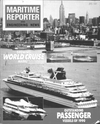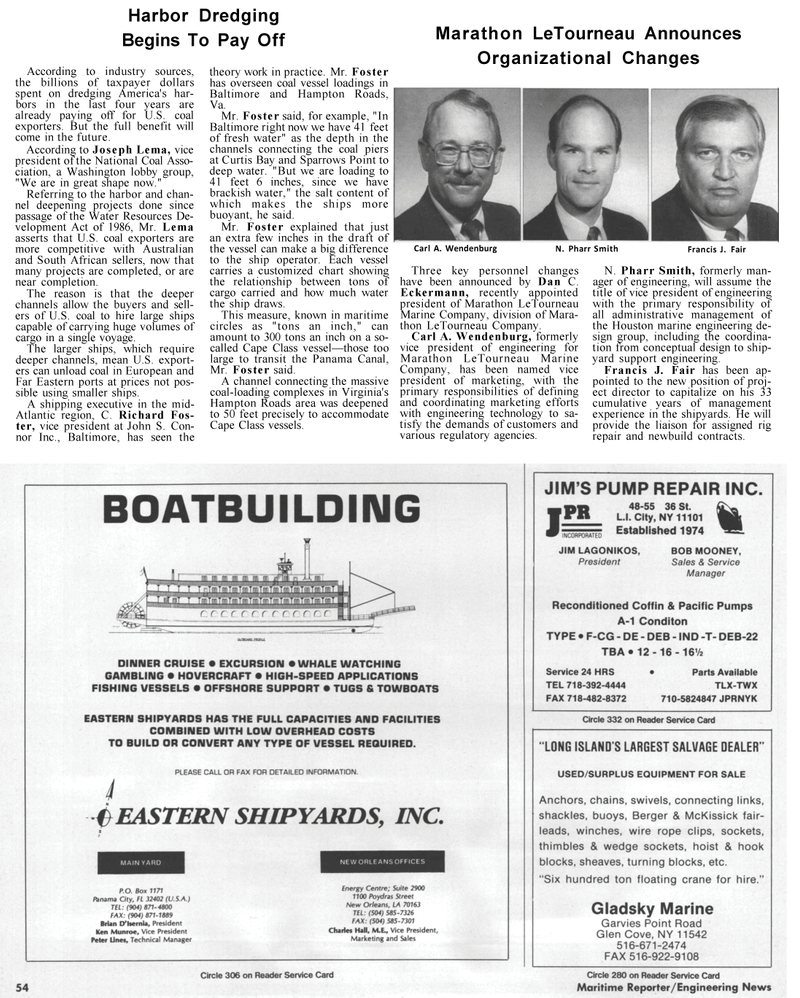
Page 50: of Maritime Reporter Magazine (January 1991)
Read this page in Pdf, Flash or Html5 edition of January 1991 Maritime Reporter Magazine
Harbor Dredging
Begins To Pay Off
According to industry sources, the billions of taxpayer dollars spent on dredging America's har- bors in the last four years are already paying off for U.S. coal exporters. But the full benefit will come in the future.
According to Joseph Lema, vice president of the National Coal Asso- ciation, a Washington lobby group, "We are in great shape now."
Referring to the harbor and chan- nel deepening projects done since passage of the Water Resources De- velopment Act of 1986, Mr. Lema asserts that U.S. coal exporters are more competitive with Australian and South African sellers, now that many projects are completed, or are near completion.
The reason is that the deeper channels allow the buyers and sell- ers of U.S. coal to hire large ships capable of carrying huge volumes of cargo in a single voyage.
The larger ships, which require deeper channels, mean U.S. export- ers can unload coal in European and
Far Eastern ports at prices not pos- sible using smaller ships.
A shipping executive in the mid-
Atlantic region, C. Richard Fos- ter, vice president at John S. Con- nor Inc., Baltimore, has seen the theory work in practice. Mr. Foster has overseen coal vessel loadings in
Baltimore and Hampton Roads,
Va.
Mr. Foster said, for example, "In
Baltimore right now we have 41 feet of fresh water" as the depth in the channels connecting the coal piers at Curtis Bay and Sparrows Point to deep water. "But we are loading to 41 feet 6 inches, since we have brackish water," the salt content of which makes the ships more buoyant, he said.
Mr. Foster explained that just an extra few inches in the draft of the vessel can make a big difference to the ship operator. Each vessel carries a customized chart showing the relationship between tons of cargo carried and how much water the ship draws.
This measure, known in maritime circles as "tons an inch," can amount to 300 tons an inch on a so- called Cape Class vessel—those too large to transit the Panama Canal,
Mr. Foster said.
A channel connecting the massive coal-loading complexes in Virginia's
Hampton Roads area was deepened to 50 feet precisely to accommodate
Cape Class vessels.
Marathon LeTourneau Announces
Organizational Changes
Carl A. Wendenburg N. Pharr Smith Francis J. Fair
Three key personnel changes have been announced by Dan C.
Eckermann, recently appointed president of Marathon LeTourneau
Marine Company, division of Mara- thon LeTourneau Company.
Carl A. Wendenburg, formerly vice president of engineering for
Marathon LeTourneau Marine
Company, has been named vice president of marketing, with the primary responsibilities of defining and coordinating marketing efforts with engineering technology to sa- tisfy the demands of customers and various regulatory agencies.
N. Pharr Smith, formerly man- ager of engineering, will assume the title of vice president of engineering with the primary responsibility of all administrative management of the Houston marine engineering de- sign group, including the coordina- tion from conceptual design to ship- yard support engineering.
Francis J. Fair has been ap- pointed to the new position of proj- ect director to capitalize on his 33 cumulative years of management experience in the shipyards. He will provide the liaison for assigned rig repair and newbuild contracts.

 49
49

 51
51
